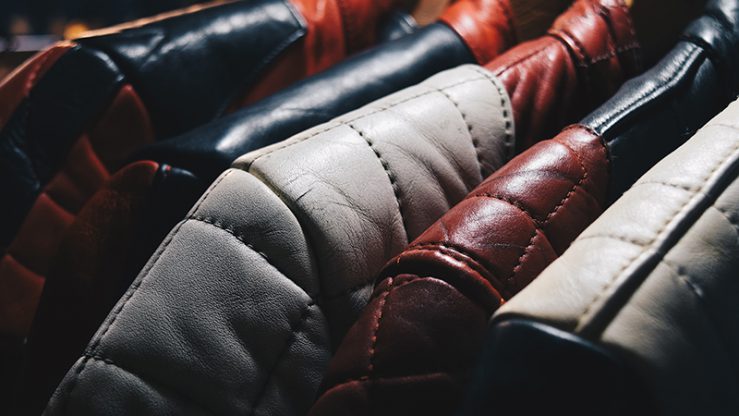That non-toxic synthetic leather smell
The road towards successful substitution of a hazardous substance can seem long, costly and daunting.
But by phasing out a harmful solvent from the manufacturing of synthetic leather, the Zero Discharge of Hazardous Substances Foundation (ZDHC) and a group of global fashion brands, with the H&M Group in the forefront, have proven that substitution is not only possible, but also necessary, highly beneficial for human health and environment – and a huge driver of innovation.
The toxic chemical
Dimethylformamide (DMFa) is a commonly used solvent in the production of plastics, rubber, and polyurethane (PU) coating, also known as synthetic leather. The chemical has a strong smell in the finished product and is also used for producing synthetic fibres.
Great! A versatile substance, right? Sure – and a highly toxic one. DMFa is easily absorbed through the skin and can cause many adverse health effects, including liver damage and infertility.
The chemical is harmful to everyone who comes in contact with it, and factory workers manufacturing synthetic leather are of course particularly at risk.
“DMFa is easily absorbed through the skin and can cause many adverse health effects, including liver damage and infertility”
DMFa has been listed as a Substance of Very High Concern (SVHC) under the REACH (Registration, Evaluation, Authorisation and Restriction of Chemicals) legislation since 2008 for good reasons.
The alternatives
The H&M Group actually preceded REACH and put DMFa on their own Restricted Substances List (RSL) as early as 2007. Three years later, the chemical was added to H&M Group’s Manufacturing Restricted Substances List (MRSL) and that’s when the quest to find alternative technologies for synthetic leather manufacturing really took off.
The fashion company involved the supply chain and chemical industry on product development and developed a certification routine to secure materials and products free from DMFa.
In 2014, the first water-based technology was introduced, replacing DMFa with water. Three years later, a non-solvent technology was developed. The only by-product of the non-solvent technology is carbon dioxide – no left-over solvent or toxic solvent evaporation.
The collective effort
So by 2017, there were at least two viable alternatives to DMFa for H&M Group to choose from. But no company is an island. Since DMFa was used in more than 99% of the global synthetic leather production, it was very difficult for a single brand to tackle the issue alone.
H&M Group and other brands had talked to producers individually, but few seemed to understand how the switch to alternative technologies should be done – or offered relevant practical support.
“But no company is an island. Since DMFa was used in more than 99% of the global synthetic leather production, it was very difficult for a single brand to tackle the issue alone”
At this point, the H&M Group sought support from the ZDHC, a global multi-stakeholder initiative of more than 160 contributors within the fashion and footwear industry – including the H&M Group, and asked them to coordinate with the synthetic leather industry.
The ZDHC had been working on the DMFa issue since 2015, when they sought collaboration with the China Synthetic Leather Industry Association (CPASL), as well as the Chinese government, who were also interested in reducing the use of DMFa and similar chemicals.
The ZDHC was able to channel the leverage of its 160 contributing fashion and footwear brands to influence the entire supply chain, including chemical companies and PU-producers, as well as other textile and footwear manufacturers and brands.
When issues such as quality, durability, development and production costs had been sorted out, brands gained trust in the new material and technologies, which led to an increase in production and order placements.
The result
The H&M Group has been manufacturing large quantities of synthetic leather with the non-solvent technology since 2018. In September of 2020, 79% of the company’s synthetic leather was produced without DMFa. Although they are on track towards 100%, some technical challenges remain, for example poor abrasion and flexing when the material is used with glitter, metallic and all over prints.
After the ZDHC helped run the DMFa phase-out pilot in China, a lot of things changed. More chemical companies increased investment and technology development, and more and more companies are transferring from traditional production of synthetic leather to DMFa-free manufacturing.
In China, between 2015 and 2019, the production of water-based synthetic leather increase with 600%, while non-solvent produced PU increased with 460%.
“This story shows that collaborative efforts, open communication and stakeholder engagement can bring more lasting sustainable change to an industry than individual action could”
The ZDHC brands play a key role in the DMFa phase-out and are highly acknowledged for this in the industry. The brands and their suppliers are leading the way to safer production of synthetic leather. Some have already eliminated the chemical from their production entirely. DMFa is well on the way towards finally becoming redundant in the synthetic leather manufacturing process.
“Changing an industry and adopting better production practices does not happen overnight, even if technical solutions seem to be within reach. The process of substituting DMFa, like many others, needs a mindshift. This story shows that collaborative efforts, open communication and stakeholder engagement can bring more lasting sustainable change to an industry than individual action could. From a consumer’s perspective, the change is mostly unnoted. For producers, it is a reliable sign that brands’ commitments are put into action”, says Lydia Lin, ZDHC East Asia Regional Director.
What you can do
Toxic chemicals cause problems for human health as well as the environment, and their effects entail huge costs in terms of both money and misery.
Does your company still use DMFa or other hazardous substances in production? Take a look at the alternatives listed here on Marketplace and future-proof your business.






